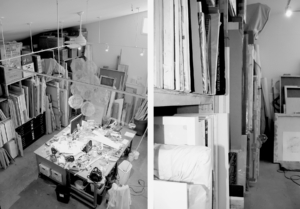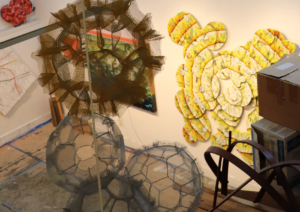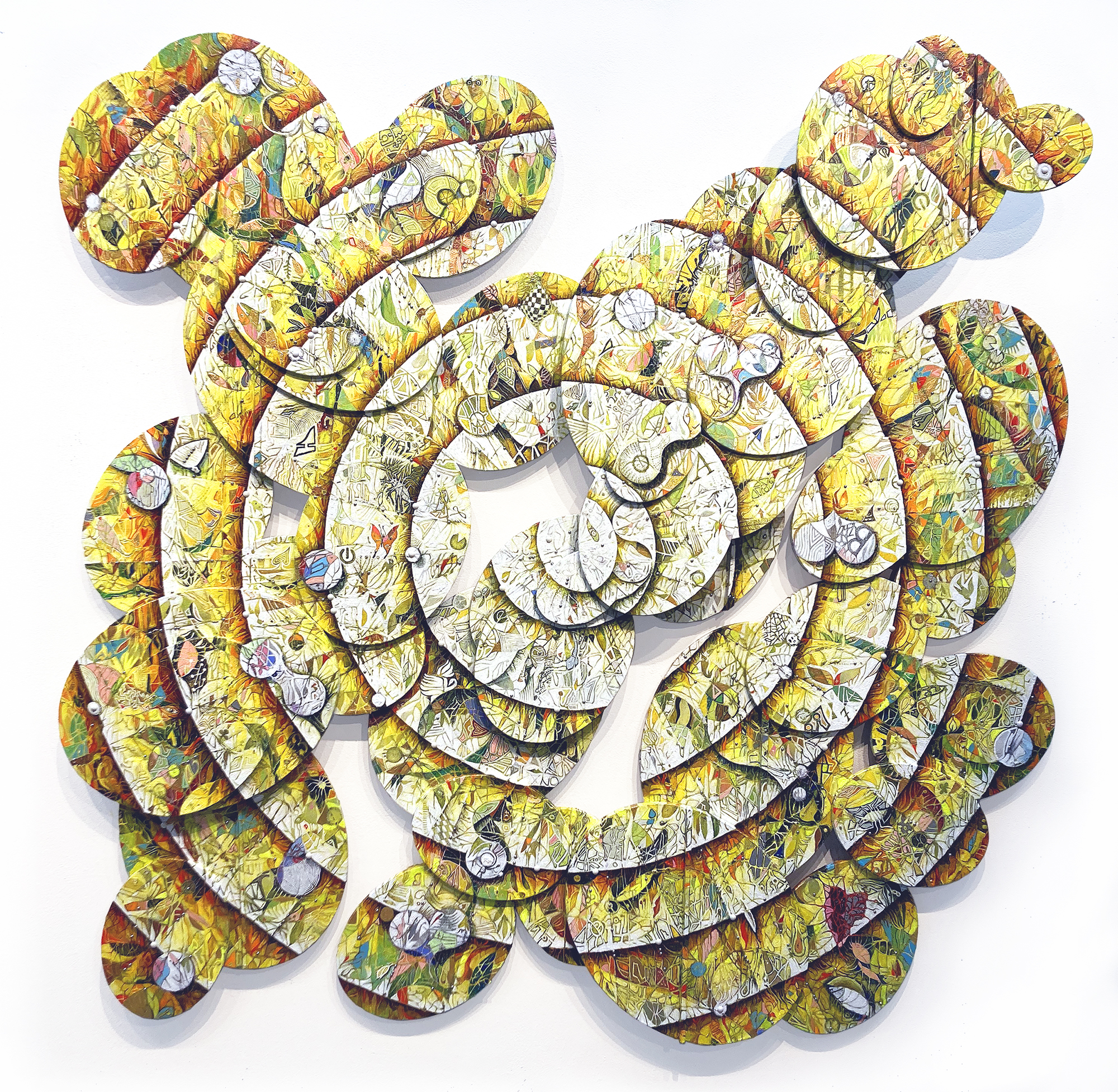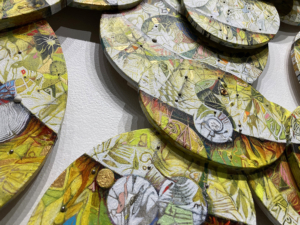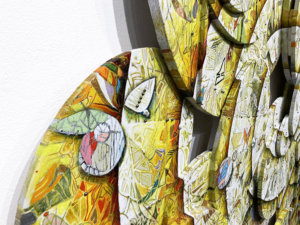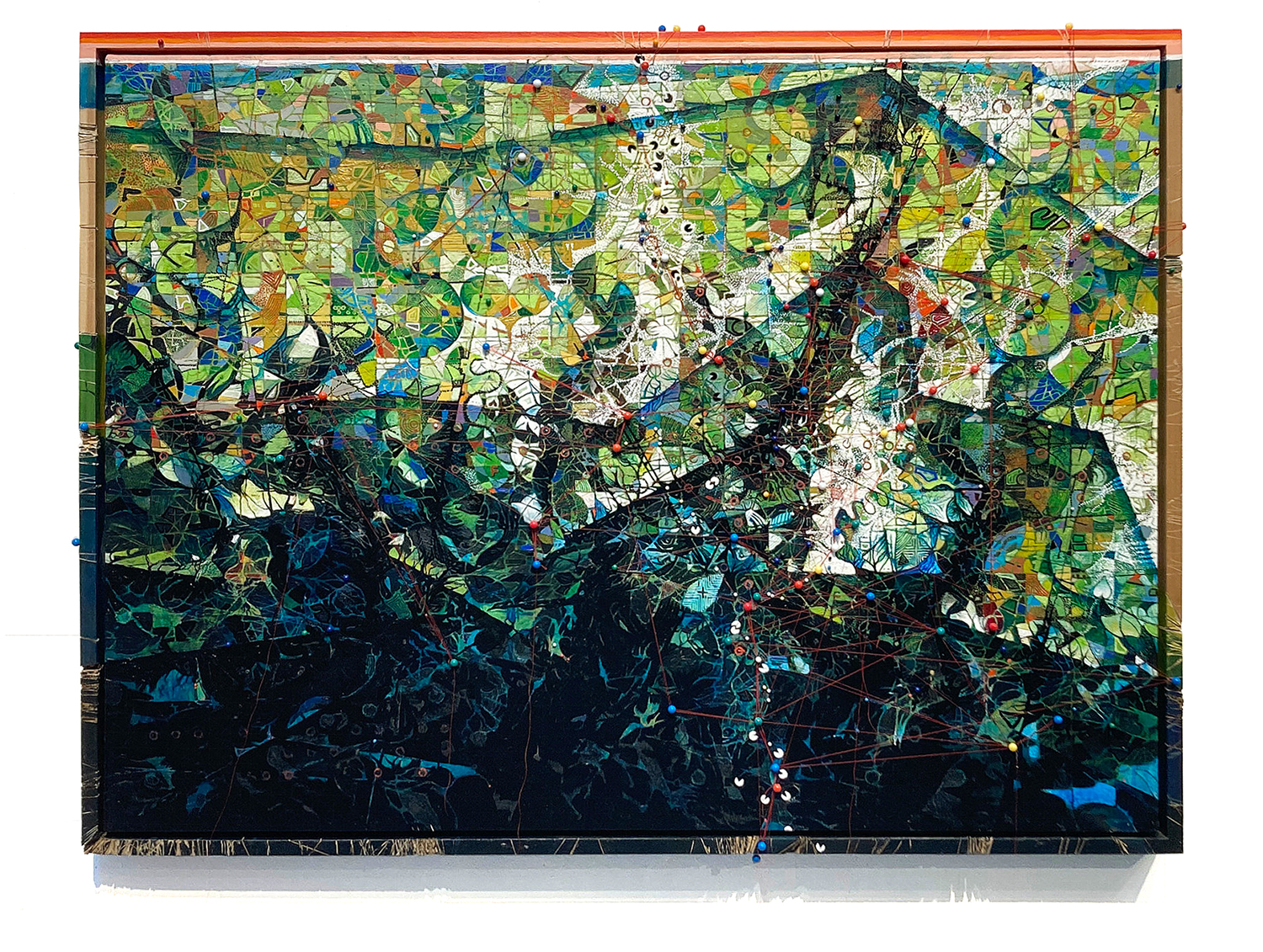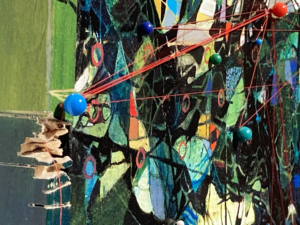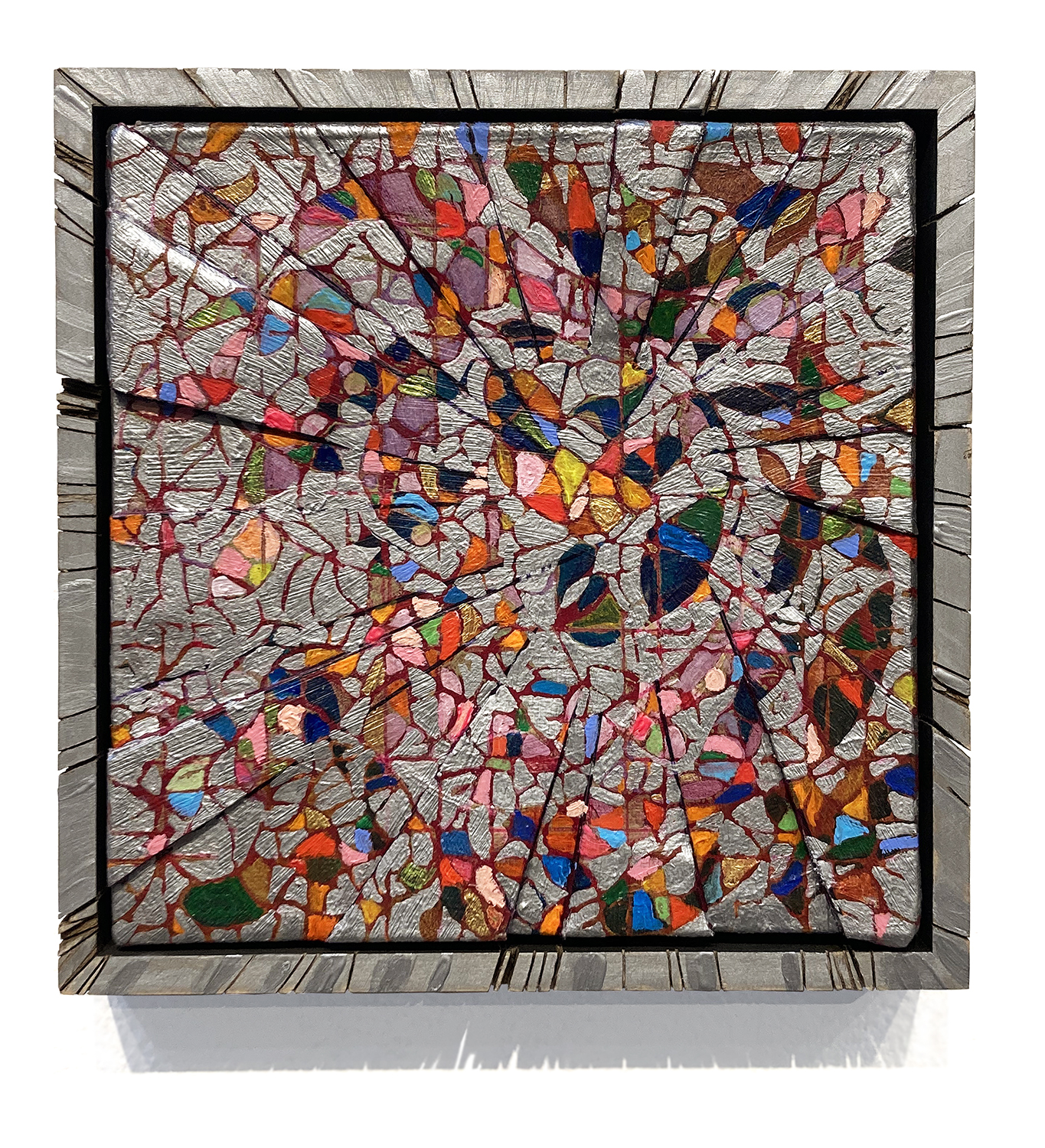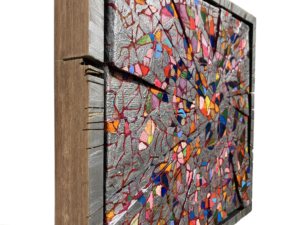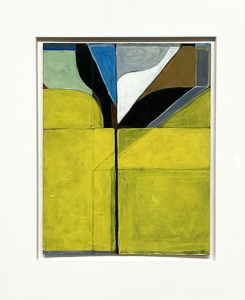There’s something to be said about showing up. About consistency. Practice, and exploration. And when doing this leads from day after day, to year after year, and now to decade after decade, this sometimes equates to forming a world. A new realm, in which both questions, answers, confusion, clarity, all co-exist together.
What am I talking about? I am talking about an artist, which upon first glance you might label “painter.” But sit a little while with his work, and ideas might swirl in your head. You might think a philosopher just whispered in your ear. Sit a while longer and you may even cease to see a painting, where only movement of thought, processes of adding, subtracting, scratching, digging, twisting and tossing it all into the air, to land in this space of its own is all that remains.
And, who am I? I am a collection as well, of fellow artist colleagues, collectors, family, friends: all who have made inquiries of what this work is all about.
CONVERSATION.01 : illusion as narrative
It starts with a bird’s eye view. And as you descend, stair by stair into the light-flooded room, decades of work, stacked vertically in 20 foot ceiling-high cubbies, wait. Layers of work are stacked against walls, waiting to have new life put into them. And then, to your right, floating on an expansive, white wall, a yellow burst of light catches your eye. In it – a world of both chaos and delight – live within its parameters, …, yet cohesively it is whole. Kenn and I begin our conversation here, in front of his latest study of geometric abstract art, a painting entitled, “a ribbon at a time,” that will be shown at the Black Mountain Center for the Arts in May and June.
a ribbon at a time
2022, mixed media on 45 canvases, 72 x 72 x 6.5 inches
This is stunning, Kenn. How did this piece come about?
K: This is titled after a line in Emily Dickinson’s poem, “I’ll tell you how the sun rose,” and how its light reaches us a ribbon at a time. As I began working, the heliocentric concept surfaced first upon adding concentric circles and gradient values/color.
“Heliocentric: Heliocentrism is the astronomical model in which the Earth and planets revolve around the Sun at the center of the Universe. Historically, heliocentrism was opposed to geocentrism, which placed the Earth at the center.” (source: Wikipedia)
We have the geocentric concept when many conservative people thought that the earth was the center of the universe. Whereas, the early Greek astronomers said, “no – we think it is the sun.” But, this idea didn’t take until around the 1500s. It was Galileo that had to recant his theory to the Catholic Inquisition and say, “okay, you guys are right, the earth is the center of the universe,” otherwise, they would have jailed him.
Finally, we realized this heliocentric notion that we are moving around the sun. I kept thinking about this idea: of light, energies, forces – all of this that would not exist if we did not have this sun.
The yellow seems to be the central, grounding force of this painting. The adjoining canvases is fascinating. What was the basis of thought for this?
K: All of the work that construct the canvases for the Black Mountain show had come to a completion at one time or another, but given history and time, didn’t work any longer. So, I deconstructed all of these canvases, took remnants of others, and re-organized it all.
Are you totally covering up what was there, or does some of it remain?
K: I keep coming back to these old creations, and wanting to re-purpose them. Some of the old line work remains, but mostly, everything has been reworked.
What themes are you working with now?
K: I am all about systems right now: everything between the grid system: of space, geography, mathematics; to language: like morse code. The idea of rhythm. I have always been fascinated by Braille. Everything is related in this fabric of systems. Parts – that make up the whole, give us this understanding of this greater, bigger picture.

I’m fascinated by that because it helps us visualize this complex information. And for me, this helps me contextualize the 60+ years I have been here on this planet. And for the first time, I’m just allowing it to pour out. I can’t even work fast enough to keep up.
There is so much layering, imagery, lines, shapes – everything going on in this painting. Can you walk us through your process?
K: It is based on this notion of pareidolia – it’s the tendency to perceive a specific, often meaningful image in a random or ambiguous visual pattern (source: Merriam Webster). Like if you’re cloud watching and you say, “look – there’s a horse, there’s a dog.” I remember in the 60s, someone saw the face of Jesus on a screen door. Thousands of people flocked to it, because of the nature of it. So one could ask, was it there? It depends on what you believe, and how much you want to believe. Pareidolia derives from apophenia. Apophenia is where, if you see something that is not there, you may not have a foot in complete reality.
“Apophenia is the tendency to perceive meaningful connections between unrelated things. The term was coined by psychiatrist Klaus Conrad in his 1958 publication on the beginning stages of schizophrenia. He defined it as ‘unmotivated seeing of connections [accompanied by] a specific feeling of abnormal meaningfulness. He described the early stages of delusional thought as self-referential over-interpretations of actual sensory perceptions, as opposed to hallucinations.” (source: Wikipedia)
So, you are putting meaning into what you are seeing? There is not objectivity?
K: Well, you are correct. All of this is bouncing between: tradition/non-tradition, abstract/realism, form/no form, subjectivity/objectivity. Because, a circle is an objective, right? But, if we actually assign it a symbol, or in some way manipulate it, then that changes it for every viewer who walks up to it. And so, what happens is, these figures start to come forward.
“There is no prescribed notion for this, It is all about process.”
When I look at “a ribbon at a time,” and I see this butterfly, do you first see the indication of this and bring it out?
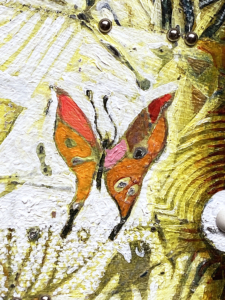 K: Yes. And, there is no prescribed notion for this piece, it is all about process. In each of these pieces for this show, I just find it interesting to overlay all of these structures: the grid, the circle, and the material also plays a part in it. I’ll do a wash or a glaze, and it begins to dry and drip, there’s darker areas to that. That is where pareidolia really comes into play.
K: Yes. And, there is no prescribed notion for this piece, it is all about process. In each of these pieces for this show, I just find it interesting to overlay all of these structures: the grid, the circle, and the material also plays a part in it. I’ll do a wash or a glaze, and it begins to dry and drip, there’s darker areas to that. That is where pareidolia really comes into play.
We move on to another geometric abstract art painting. Many organic, grid-like layers work together in the composition. Three-dimensional elements (like thread and map pins) cluster in certain areas, contrasting with flatter regions.
bang green
2022, mixed media on canvas & wood, 38 x 50 inches
In what way do you work – how do you approach a new piece?
K: I go through a series of questions and answers when I’m working, like “What’s next? I guess I will put down red.” Then this pre-supposes the next question. So, once again, the process becomes a sequence. After time, I can no longer go back and remember what the sequence was because it is not linear thinking.
And, that’s the idea, the pulling in the notion of what we call the “fabric of society.” We are all intertwined in some way or another. We are all interconnected, but we also create boundaries for ourselves. Humans can be very territorial. A lot of this series has to do with boundaries: Are they psychological? Are they physical? So then it begins to unfold into a narrative.
I see the pins extend beyond the canvas in a lot of areas, and then they seem to get lost in the painting as well. There are “real,” 3-dimensional pins, but they are also represented 2-dimensionally. There is an oscillation of depth and flatness. Now, as I get closer, I am also noticing the threads that are wound around and in between the pins. These delicate lines offer a nice contrast to the vibrant power of the piece.
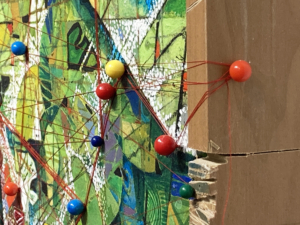 K: Exactly: is it real, or illusion? It’s another medium adding to the narrative. Many people comment when they look at this piece from a distance how 3-dimensional it appears, but the painting is “flat” of course.
K: Exactly: is it real, or illusion? It’s another medium adding to the narrative. Many people comment when they look at this piece from a distance how 3-dimensional it appears, but the painting is “flat” of course.
All of the recent work possesses a dichotomy between realism/abstraction; fact/fiction; 2-dimension/3-dimension. There are these opposing forces and conflicts present that beg resolution and offer new questions simultaneously.
persist
2022, mixed media on canvas, paper & wood, 8 x 8 inches
Oh, this is a tiny, but powerful piece – I love it!
K: When I researched the symbolism of silver – I found it is a very feminine color, and one reason, is because women are persistent. And I thought, “I like that.” So, I took that trait and had to be very persistent to get this thing to work. {smiles} If you look closely, you can see the build up of paint. This canvas has been floating around for years.
The lines extend, and are literally dug into the frame. What does that mean to you?
K: Edgar Degas stated that “the frame is the reward for the artist.” I have always had a problem with framing. Because once you do something, even if it is rectilinear, the frame interrupts the energy, the movement, the integrity of the piece. For one, I have always worked to the edge anyway. If you buy a traditional frame, you have a lip that’s going to cover 1/4” all the way around. That doesn’t work with a highly textured piece, so then you can use a floater frame. But, floater frames are fabricated by someone else, so you’re therefore bringing in someone else’s idea, or aesthetic into your piece. I wanted the painting and the frame to have that marriage, that symbiotic relationship – that the frame is also adhering to the forces within the painting itself.
“A rectilinear polygon is a polygon all of whose edge intersections are at right angles. Thus the interior angle at each vertex is either 90° or 270°. Rectilinear polygons are a special case of isothetic polygons.” (source: Wikipedia)
It feels like they are, not just talking to each other, but there is literal motion coming out from the painting into the frame, and that energy even radiates beyond the frame.
K: Yes. It places the painting as a form into a particular milieu, right: this now becomes integrated within its environment. Once again, you no longer have just a rectilinear frame.
fleur-de-lis #6
1999, oil on paper, 9×7.5 inches. Private Collection
When you look at the whole of an artist’s work, in a linear timeline, hind sight is a wonderful thing. Looking around his studio I notice a small, framed piece from a series Kenn created twenty years ago. This piece subtly hints at where his geometric abstract art will lead.
“fleur-de-lis #6”, is painted right to the end of the canvas, and therefore has a variant edge all around. The piece was mounted with a 1/4” margin from the matte to give the painting some air.
This latest series, “order in an unruly zoo” will be exhibited May 6th – June 10th at Black Mountain Center for the Arts.
Reception, Friday May 6, 5:30-7:30 pm
BMCA
225 W State St., Black Mountain, NC, 28711
828-669-0930

